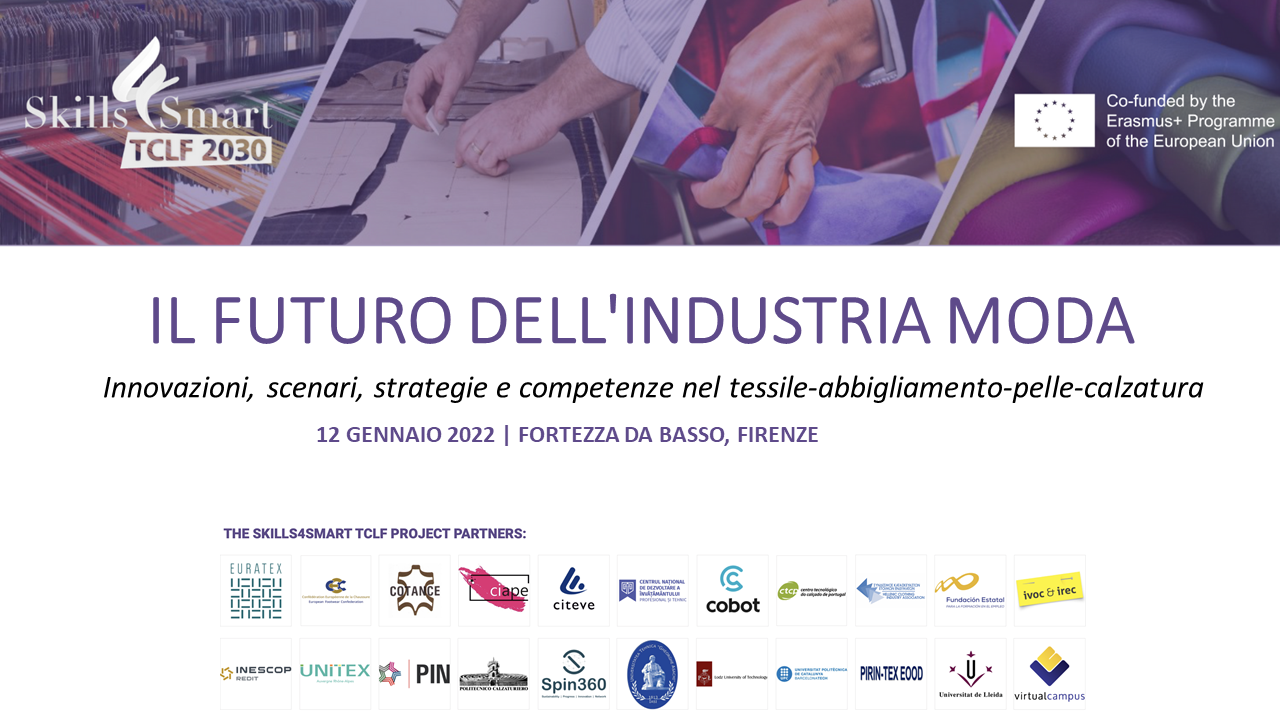Numerous contributions were made during the international conference entitled “The future of Fashion industry: innovations, scenarios, strategies and skills in the textile, clothing, leather and footwear” which took place on 12 January at Fortezza da Basso in Florence, within the evocative setting of Pitti Uomo.
60 participants physically present, 377 in live streaming with connections from Portugal, France, Belgium, Spain, Romania, Germany, Poland, Greece, Sweden, Hungary, Czech Republic, United States, Brazil, Netherlands, Russia, Ukraine, UK, Armenia, South Africa. Among these, about 70 fashion-oriented high schools that participated with the students, for a total of over 2000 people who attended the event.
Pitti Immagine and Centro Firenze per la Moda have shown great sensitivity to the themes of the Erasmus + Skills4Smart TCLF 2030 project, allowing the event to be held within the Pitti Uomo fair in Florence. The day was organized by the Italian partners of the project, in particular PIN-Polo Universitario di Prato and Politecnico Calzaturiero, and with the great support of Confindustria Moda and its Education committee. The subject of the event will be the innovations, scenarios, strategies and skills in the fashion manufacturing sector: textile, clothing, leather and footwear.
The theme of training young people, reskilling and upskilling of workers is really strong for Europe, as recalled by the three representatives of the European trade associations: Dirk Vantyghem – Euratex General Director (textile and clothing), Carmen Arias Castellano – CEC General Secretary (footwear) and Gustavo Gonzalez-Quijano, Cotance General Secretary (tanning) who started the event.
Daniela Toccafondi, President of PIN – Prato, coordinated the first session of the event where Katarzyna Sulisz, Euratex Policy officer, framed the main problems in the textile-clothing-leather-footwear sectors faced by Skills4smart TCLF 2030 project. In 2020, 36% of the workforce in the Fashion industry was over the age of 50, an increase of two percentage points compared to 2019. 61% of companies will need digital skills, 40% of companies will need green skills. Again: forecasts give over 700 000 workers leaving the fashion sector in Europe, who will have to be replaced. A concern for the European textile-clothing-leather-footwear sector but above all for Italy, given that it is the country with the highest number of workers (about 410 000), followed by Romania (almost 300 000), Poland (almost 200 000) and Portugal (about 180 000).
The project has elaborated the possible scenarios of the future of the sector, in order to develop local, national and European strategies. The result was that, in a short time, it is necessary to support the sector with effective strategies and actions: education, professional technical training and post-diploma training were topics at the center of the debate. ““The fashion supply chain must be put at the center and follow new patterns” argued the president of Herno and of Pitti Immagine, Claudio Marenzi, during the round table monitored by Federico Brugnoli – CEO of Spin 360. “Made in Italy will maintain its competitive advantage only through the skills of our master craftsmen and the digital skills of the young people”, confirmed Bruno Conterno, CEO of Nice Footwear.
For the tanning sector, Graziano Balducci – CEO of Conceria Antiba, president of Stazione Sperimentale per l’Industria delle Pelli e delle Materie Concianti (SSIP) and Vice-President of UNIC-Italian Tanneries, highlights such as “The tanning industry invoices 5 billion euros, but with the leather we make 100 billion of finished leather products. Sustainability is a priority: we are using bio chemicals, processes that reduce the use of water. We have a very ambitious project, “zero impact”, which goes precisely in this direction.”
Maurizio Sarti – CEO of Faliero Sarti and president of the Fashion section of Confindustria Toscana Nord – focuses on sustainability, which is part of the Italian tradition and recalls the need to reinterpret it in the light of new technologies: “We must defend our heritage, enhance the “beauty” which, however, must be combined with innovation, new skills. Training and attracting young people are fundamental. New technologies must be integrated with tradition”.
An important role is attributed to policy makers, that during the works gave a guarantee of continuity in the commitment to adapt the training policies of the sector. Cristina Grieco, adviser of the Ministry of Education, recalled the protocol signed by Minister Patrizio Bianchi with Confindustria Moda, renewed last November, which envisages “a complete collaboration to create synergy between schools, training institutions and companies, with the objective of guaranteeing good employability and employment for young people. A balance must be found between theoretical and applicative training “.
Tuscany Region heavily focuses on collaboration with individual territories for the development of skills that respond to the needs of the districts. The virtuous example of Prato area is an example of this. With the “Local Pact for the development and enhancement of skills”, signed between the Region and the Municipality of Prato and other actors in the world of business and work, coordination and territorial oversight is possible that is important and consistent with the European guidelines of the European Pact of Skills. “We are in a moment of great opportunity with PNRR funds and the resources of the new seven-year European funds. Today training and active labor policies are back at the centre of the institutional political debate”.
In the second section of the event, coordinated by Alessandro De Rosa – High Education Manager of the PIN – Prato, there were presented the tools developed by the European project “S4TCLF – Skills 4 Smart TCLF Industries 2030” (www.s4tclfblueprint.eu) in support of the training system. Christian Baio, project manager of Spin 360, presented the “European Fashion Campus” – www.europeanfashioncampus.com, a portal that allows you to access useful information for the world of education and training, to share information on the sector, and to create networks.
Alice Marcato, project manager of Politecnico Calzaturiero, presented then the e-learning platform with the eight training courses developed around the professional profiles which, according to the needs analysis carried out within the European project, will have greater development in the coming years: Textile Technologist, Clothing CAD Pattern Maker, Leather Technologist, Footwear 3D CAD Pattern Maker, Sustainability Expert, Supply Chain Manager, Digital Marketing Expert, Process and Production Timeline Analyst. A large database of didactic contents (51 didactic units, 213 videos), to guide and train young people and update employees, but also to curve educational paths.
Confindustria Moda supported the organization of the event by underlining the commitment that the Education Committee has been carrying out for years. Paolo Bastianello, president of the Committee, underlined that the technical figures are the most difficult to find; it is necessary to more involve schoolteachers, improve the guidance system, increase enrolment in education and vocational training courses and, as a priority, the training of trainers. The greatest results are seen when the business is involved, because it is dynamic, more reactive, and aware of changes. The business must play an important role in the training processes, and this is demonstrated by the results of the ITS courses (Higher Technical Institutes) specialized in the fashion sector managed by the 8 foundations in Italy (in Piedmont, Veneto, Lombardy, Tuscany, Abruzzo, Campania, Marche). The training model was presented by Antonella Vitiello, general director of Mita Foundation in Scandicci, who underlined how the strength of this two-year training segment is represented by the strong presence of teachers from the world of work, entrepreneurs, from practical activities in the laboratory and in the company, as well as from an internship lasting 600 hours.
At the end of the event, a video-documentary entitled “Inside the Fashion Industry” was screened, made by the well-known movie director Tommaso Santi in European manufacturers, and intended for widespread circulation, to inform young people of the potential and hyper-specializations required by the world of fashion.
For those interested in learning more about our event we invite you to check the recording of the event and other supporting materials available here.


